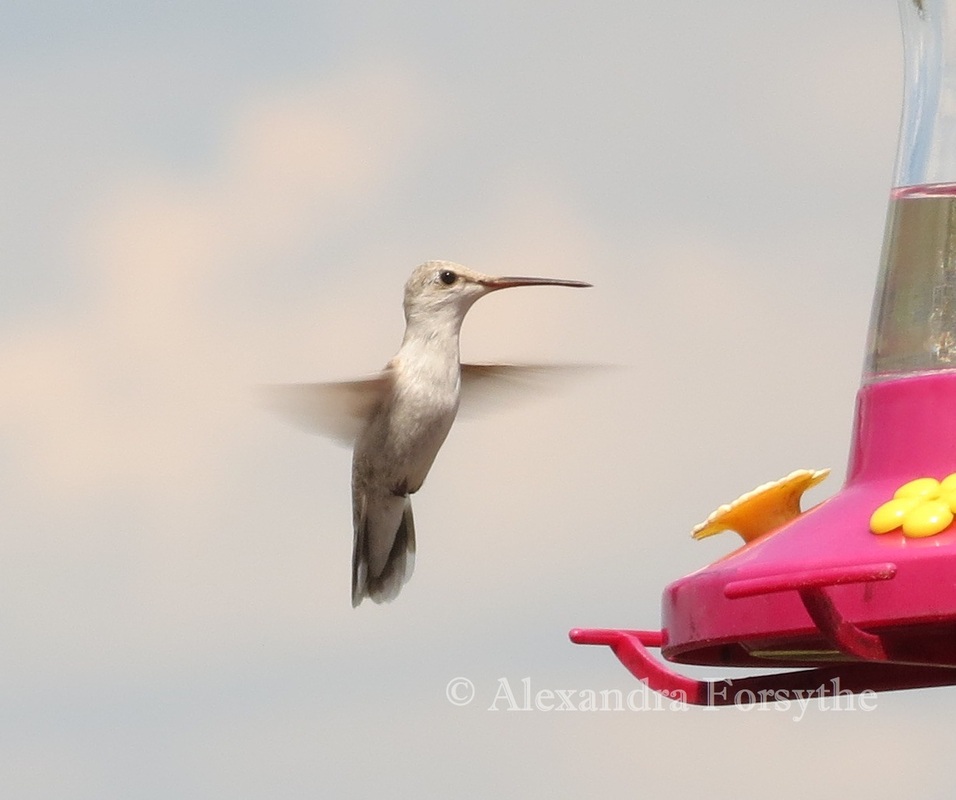Is this hummingbird an albino? Or is it suffering from leucism? Or perhaps it is displaying signs of dilution? Or maybe it has a condition causing progressive greying? The answer might depend on whom you ask.
There has been some confusion and disagreement in the scientific community about the exact nature of each of these conditions. For example, is leucism caused by a lack of pigment? Or by a significant reduction in the amount of pigment deposited in the feathers? We aren’t completely certain. However, the basic cause and definition of each condition is generally agreed upon.
Albinism is caused by a genetic mutation that results in a complete absence of tyrosinase in pigment cells. Tyrosinase is an enzyme that is located in melanocytes. Melanocytes produce melanin, which is the substance that gives your skin, hair and eyes their color, and it gives color to a bird’s feathers. With no tyrosinase, no melanin is produced, so a bird’s feathers will appear white, and the eyes will appear pink. Albinism also affects the bird’s eyesight, causing the bird to have difficulty spotting predators and shortening its lifespan. Since albinism is an all-or-nothing condition, there is no such thing as “partially albino”.
Leucism is a reduction, rather than a complete lack, of pigment. Birds with leucism may have a few white feathers (partially leucistic), or be predominantly white, depending on the extent of the condition. Leucism is inherited, but it usually displays differently in the parents than in the offspring. A parent may have white feathers on the wings, while the offspring has white feathers on the tail, for example. It is an inherited trait, but it is recessive so it can skip generations.
Dilution is a condition that causes the feathers to appear more pale than normal. The bird may appear to have been sprayed with a fine mist of white paint and look washed out. In these birds, the melanin is present, but the cells are not producing as much pigment as normal birds.
Progressive greying or vitiligo results in white feathers, but the change occurs over time. The bird may have normal coloring when young, but the bird turns whiter as it ages. It is caused by the progressive loss of pigment cells with age.
So which condition does this hummingbird have? I’ll let you be the judge!
There has been some confusion and disagreement in the scientific community about the exact nature of each of these conditions. For example, is leucism caused by a lack of pigment? Or by a significant reduction in the amount of pigment deposited in the feathers? We aren’t completely certain. However, the basic cause and definition of each condition is generally agreed upon.
Albinism is caused by a genetic mutation that results in a complete absence of tyrosinase in pigment cells. Tyrosinase is an enzyme that is located in melanocytes. Melanocytes produce melanin, which is the substance that gives your skin, hair and eyes their color, and it gives color to a bird’s feathers. With no tyrosinase, no melanin is produced, so a bird’s feathers will appear white, and the eyes will appear pink. Albinism also affects the bird’s eyesight, causing the bird to have difficulty spotting predators and shortening its lifespan. Since albinism is an all-or-nothing condition, there is no such thing as “partially albino”.
Leucism is a reduction, rather than a complete lack, of pigment. Birds with leucism may have a few white feathers (partially leucistic), or be predominantly white, depending on the extent of the condition. Leucism is inherited, but it usually displays differently in the parents than in the offspring. A parent may have white feathers on the wings, while the offspring has white feathers on the tail, for example. It is an inherited trait, but it is recessive so it can skip generations.
Dilution is a condition that causes the feathers to appear more pale than normal. The bird may appear to have been sprayed with a fine mist of white paint and look washed out. In these birds, the melanin is present, but the cells are not producing as much pigment as normal birds.
Progressive greying or vitiligo results in white feathers, but the change occurs over time. The bird may have normal coloring when young, but the bird turns whiter as it ages. It is caused by the progressive loss of pigment cells with age.
So which condition does this hummingbird have? I’ll let you be the judge!

 RSS Feed
RSS Feed
